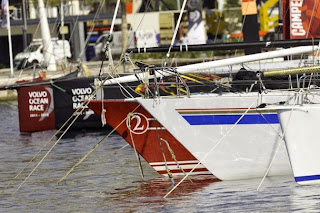As we’ve seen in previous posts, conventional hulls resist bow down trimming forces by immersing more volume forward.
This shifts the centre of buoyancy forward.
If the centre of gravity remains stationary or moves aft, the resulting separation gives a bow up righting moment.Tornado style ‘conventional’ raked bow profiles indicate flared hull sections.
Meaning the sections get wider moving up, resulting in more volume at the top of the bow.
Such additional volume in the upper part of the hull is what we mean by ‘reserve buoyancy’.
This shifts the centre of buoyancy forward.
If the centre of gravity remains stationary or moves aft, the resulting separation gives a bow up righting moment.Tornado style ‘conventional’ raked bow profiles indicate flared hull sections.
Meaning the sections get wider moving up, resulting in more volume at the top of the bow.
Such additional volume in the upper part of the hull is what we mean by ‘reserve buoyancy’.
 |
| Compare the two IOR maxi bows in the foreground with the modern VO70 bows in the background. The hollow profile of the red bow (Steinlager II) reflects progressively widening flare in the topsides. In some cases the bow rake is made less extreme by ‘cheating’ the natural intersections of the two hull halves with a variable radius between the two surfaces. Image source |
Downwind
Conventional bows seek to marry a fine waterline entry with extra volume that only becomes immersed when needed.
Inherent in this mechanism is a need for significant bow down trim in order for the reserve buoyancy to take effect.
On a conventional multihull this is not a problem: As the bow is pressed down, the boat will keep sailing horizontally along the surface as the bow immerses. The additional volume going into the water at the front will shift the CB forward and a new equilibrium will be reached. A few degrees of bow down trim has no adverse effect.
 |
| Boat trims bow-down and reserve buoyancy gets to work. Image source |
The limiting factors in this case are bow freeboard and additional hull drag due to the progressively blunter entry of the trimmed immersed shape.
Freeboard limits the absolute amount of reserve buoyancy available. Hence the use of ‘ski jumps‘.
Additional drag limits acceleration which in turn affects apparent wind (accelerating downwind reduces pressure in the rig, relieving bow down trimming moment).
Multihull evolution has seen reserve buoyancy move down, progressively closer to the normal water level. Meaning sections have developed from being ‘V’ shaped to more ‘U’ shaped. It is no coincidence that this trend occurred at the same time as the advent of angled/curved foils.
Imagine a conventional Tornado style hull with angled or curved foils.
When reaching at speed the foils would be providing significant vertical force helping to keep the bow up and reducing effective displacement.
When reaching at speed the foils would be providing significant vertical force helping to keep the bow up and reducing effective displacement.
Now imagine this hypothetical boat encountering a gust: The rig would power up and press the bow down. Since the reserve buoyancy is some distance above the water, bow down trim would initially increase to bring the reserve buoyancy into play.
But at the same time the bow down trim would reduce the angle of attack of the foils, possibly even bringing it below neutral.
The boat would not tend to follow the water surface. Instead it would want to follow the chord line of the foils. This would create a feedback loop where bow down trim would increase bow down trimming force…
Having reserve buoyancy low down in the bow sections makes it immediately available. This is desirable when pitch attitude is critical such as on foil assisted boats.
When things get out of shape, the wide flat deck of a conventional hull abruptly increases drag at the very point where reserve buoyancy runs out.
A carefully shaped ‘upside down’ bow brings the water flow back together cleanly above it, giving the boat a better chance of accelerating and shedding water to allow the bow to pop back up.
 |
| Image source |
But this is not the exclusive preserve of radical inverted bows.
More moderate shapes such as the Boyer MkIV A Cat still benefit from this effect.
This brings us back to the premise that ‘wave piercing bow’ is too generic a term to be indicative of behaviour or performance.
The vertical location of the maximum section width is the feature that tells you the most about the design priorities of a particular boat.
More moderate shapes such as the Boyer MkIV A Cat still benefit from this effect.
This brings us back to the premise that ‘wave piercing bow’ is too generic a term to be indicative of behaviour or performance.
The vertical location of the maximum section width is the feature that tells you the most about the design priorities of a particular boat.
The bow profile is an indication of this vertical volume distribution.
In the final Part 3 we will look at the more subtle considerations of straight line sailing and wave induced pitching.